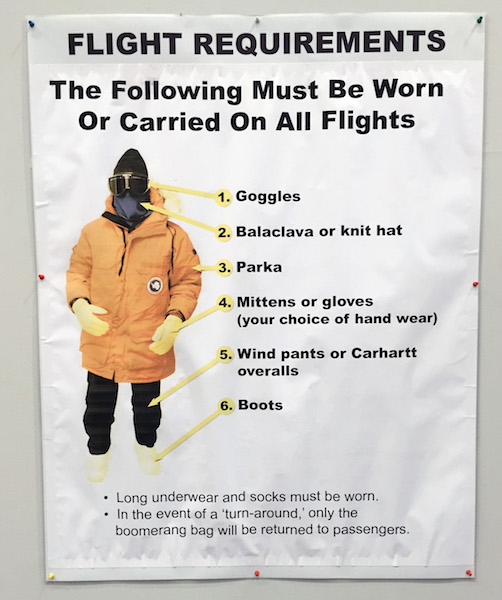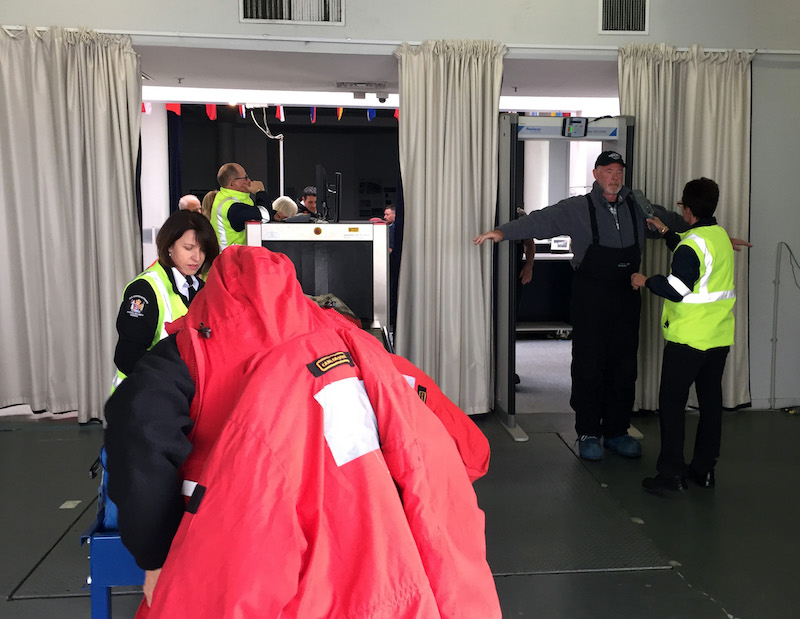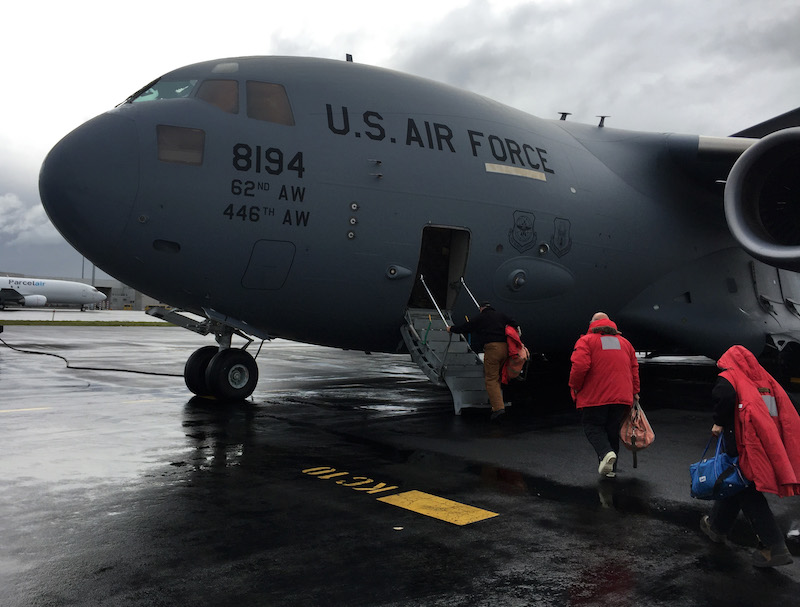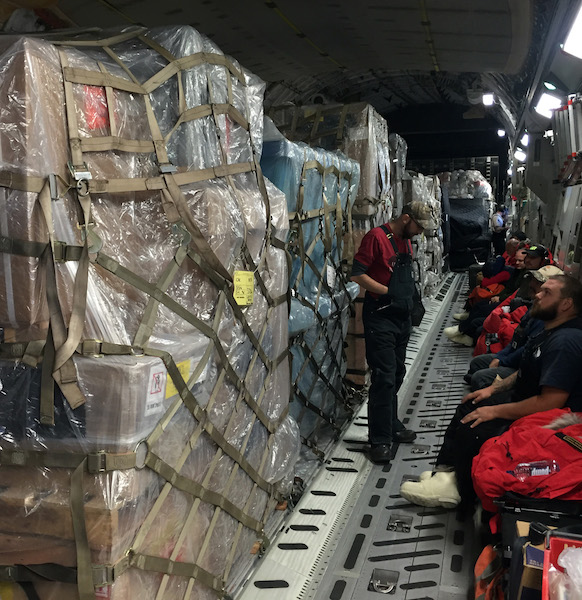McMurdo Station, Antarctica
August 29, 2016
After spending a week in Christchurch waiting for good weather for my flight to Antarctica I arrived at McMurdo Station on Saturday evening (August 27th). As you’d expect, flying to Antarctica is not like your typical commercial airline flight, although there are some similarities.
Just like for a commercial flight, you need to arrive at the airport several hours before your flight departs. Our flight was scheduled to leave Christchurch at 1:30PM and we needed to arrive at the United States Antarctic Program complex at the Christchurch airport by 11AM. Once we were at the airport we needed to finish packing our bags by merging what we brought from home with the cold weather gear we were issued earlier in the week. Just like on a commercial flight we had a weight limit as to how much checked luggage we could bring. For the Antarctic flight this limit was 80 pounds. As we packed we also had to put on our cold weather gear since it would be much colder in Antarctica than it was in Christchurch.

A poster at the United States Antarctic Program complex at the Christchurch airport reminding us of what cold weather gear we needed to wear on our flight to Antarctica.
Once our bags were packed we had to check in for the flight – just like for a commercial flight. In this case we didn’t have an airline ticket. Instead we just needed to give our name and show our passport at the check in desk and they made sure that we were on the list of people scheduled to fly to Antarctica. After that we had some free time that we could spend in a waiting lounge or to wander off to find a bit to eat before the flight. I went to a café at the International Antarctic Centre, a very popular tourist attraction in Christchurch, that is an interactive museum about Antarctica. When I arrived there were lots of tourists around including a group of kids at a birthday party. Myself, and my fellow Antarctic travelers, in our bulky cold weather gear didn’t blend in too well with the tourists. Maybe they thought we worked at the museum and were just wearing Antarctic costumes as part of our job at the museum.
Eventually it was time to board the plane. Just like for a commercial flight we need to go through airport security, including an X-ray for our carry on bag and a metal detector for us.
Next we boarded a bus that drove us onto the airport taxiway and to our waiting United States Air Force transport plane.
There are several different planes used to fly to Antarctica. The US Air Force flies C-130 and C-17 military transport planes from Christchurch to Antarctica. The New Zealand and Australian Antarctic programs have Boeing and Airbus jets that have been repurposed for flying to Antarctica by their air forces. For my flight to Antarctic this time I was flying on a US C-17, although on previous trips I’ve flown on all of the other planes as well.
The accommodations on the C-17 are not what you’d find on a commercial flight. Nylon webbing seats lined the sidewalls of the plane while pallets of cargo filled the center of the aircraft. There were only 21 passengers on this flight so it wasn’t too crowded and was actually a very comfortable flight to Antarctica.
The flight to Antarctica takes about 5.5 hours on a C-17 but can be as long as 9 hours on a C-130. We left Christchurch just about on schedule at 1:30PM and landed in Antarctica at 7PM. The runway in Antarctica is an ice runway. A few years ago I was interviewed on a Travel channel series called the World’s Most Dangerous. The episode I was on was about the world’s most dangerous runways and one part of that show talked about the ice runways in Antarctica. There are a few runways near McMurdo Station. The one we landed on is called the Pegasus runway and is an ice runway located on permanent glacial ice that is part of the Ross Ice Shelf. The ice there is hundreds of feet thick. A second runway is on a snow surface on the Ross Ice Shelf and can only be used by ski-equipped planes. The third runway is a temporary runway that is built on sea ice in McMurdo Sound. The sea ice forms each winter as the water of McMurdo Sound freezes and is several feet thick and actually flexes as the planes land and take-off from it. When I leave Antarctica in October I might fly from this sea ice runway as it is usually used from October until early summer, when the sea ice starts to melt and becomes to thin to safely support planes taking off and landing.
When the pilot announced that we had begun our descent to the Pegasus runway you could sense that everyone got a bit more excited. Most of the people that work in Antarctica have been working here for years – I’ve seen some of the same people since my first trip to Antarctica in 1994 more than 20 years ago – so sometimes we are a bit jaded about making another trip to Antarctica. I know I wasn’t nearly as excited for this, my thirteenth trip to Antarctica, as I was for my first trip, but once the pilot told us we were getting ready to land I did start to become excited. It really is a unique experience stepping off of a plane and out into the Antarctic wilderness. As I stepped off of the plane I was greeted by the cold Antarctic night. The temperature when we landed was -12 degrees F with just a bit of wind. Unlike most of my summer trips, when it is daylight 24 hours a day, it was dark with just the lights from the plane and a few waiting vehicles lighting up our surroundings. I was definitely not in Christchurch anymore. It is such a foreign environment in Antarctica that you almost feel like you’ve stepped off of the plane and onto another planet. Certainly you are about as far from the rest of the planet as you can be when you are in Antarctica.

I’ve just stepped off of the plane and into a completely different environment than the one I left just 6 hours earlier.
A couple of large vans met our plane and drove the passengers from the Pegasus runway to McMurdo Station – our home for the next month or more. The drive to McMurdo takes about 30 minutes. Our first stop in McMurdo was at a building called the National Science Foundation (NSF) chalet. Here we were giving an in-brief reminding us of some basic safety items and general rules for living and working in Antarctica.
Next we went off to the galley for a late dinner. Finally, we ventured to a cargo building to get our checked luggage, and then finally to our dorm rooms to unpack.

The dorm rooms are basic but comfortable. In my room we’ve used the dresser cabinets (on the right) to divide the room so there is some privacy between the beds. I’m sharing my room with one other person, another scientist working on a project studying Antarctic clouds.
The first few days in Antarctica are usually spent unpacking cargo, attending various training classes, and just getting settled into a new routine. Our first full day in Antarctica was Sunday (August 28th). Sunday is the only non-work day of the week in McMurdo so not much was happening. I spent a lot of the day in my office at the Crary lab taking care of work items.

The Crary Lab is where most of the scientists in McMurdo Station work when they are in town. I’ll spend a fair bit of time here but also quite a bit of time at the Pegasus runway conducting UAV flights on this trip.
The weather since I’ve landed has been relatively mild – the coldest temperature has been -13 degrees F and the warmest temperature has been -2 degrees F. At this time of year we can see temperatures dropping to -40 degrees F or colder, with wind chill temperatures approaching -100 degrees F, or temperatures as warm as the teens F above zero. The wind really makes a difference as to how unpleasant these temperatures feel, although when the temperature drops below -20 degrees F, it always feels cold when you step outside. Because it is so cold you need to wear a lot of clothes every time you step outside. On a typical day in McMurdo at this time of year I will wear long underwear tops and bottoms as a base layer, a pair of pants over that, a fleece jacket, a large parka, a hat, and gloves just to walk between buildings in town. If I’m going to be outside for an extended period of time I’ll also wear a pair of windproof pants, a neck gaiter, a face mask, and goggles. If you are spending more than just a few minutes outside you can’t afford to leave any skin exposes or you risk getting frostbite. It doesn’t take too long for it to get old having to put on and take off so many clothes every time you go outside.
Normally there are three meal times in the galley each day, but on Sundays there is brunch from 10AM to 1PM and dinner from 5 to 7PM. The galley is a large cafeteria with serve yourself food.
There are lots of recreational opportunities in McMurdo. There are two bars, a coffee house, a couple of gyms, a library, TV lounges, and hiking trails. I usually take advantage of all of these recreational opportunities at some point during my stays in McMurdo. I spent part of my day at what is known as the gerbil gym. This is the aerobics gym with stationary bikes, treadmills, and stairsteppers. The name gerbil gym comes from the fact that if you go there you are like a gerbil running on a treadmill in its cage. That name is typical of the sense of “humor” here in McMurdo.

Inside the gerbil gym. I’ll look forward to getting home and being able to ride my bicycle outside after a month of riding and running in here.
On my next post I’ll talk a bit more about the work that Mark and I will be doing in Antarctica.









John,
Thank you for the informative communication. The weather sounds like Wisconsin, and I’m impressed that the bars fall under the “recreational opportunities” category.
I look forward to more updates.
Be safe!
Todd, Antarctica is a lot like WI and bars are definitely a recreational opportunity here 🙂
So many changes from my last trip down. It is amazing how different the galley looks. And the gerbil gym!
Be safe and keep an eye on Mark too!
Rob
Mark and I have been talking about how much things have changed here since our first trip in 1994. Neither of us could remember the details of the old galley other than that it was split into an officers and enlisted side.
Loved your blog. I am one of Patsy’s friends. I am so glad that she shared this. Thanks for writing.
Thanks. I’m always glad to have new people following the blog.
What’s the indoor temperature at McMurdo? Do they keep it slightly colder so that all the extra layers (long underwear, etc.) don’t become too uncomfortable or do they heat it like office building everywhere (around 70F)?
The buildings here are generally a bit cooler than in the US. My dorm room temperature is a little colder than 65 F. Our lab is quite cold – about 55 to 60 F – but my office is warm and I need to pull off some of my layers when I’m there.
I am from indian scientific expedition in antarctica “Maitri”.
We are always looking forward to find whats happening around in antarctica and always want to especially at Macmurdo.
I am a meteorologist here and would like to interact with others from my field and share information.
Take care.
I love traveling and I like your blog.
Hello,
Thank you so much for posting this detailed account. I have a friend who has just gone down there and this really gives me a great idea of how daily life could be. What an incredible experience! Thanks for writing and for your research!